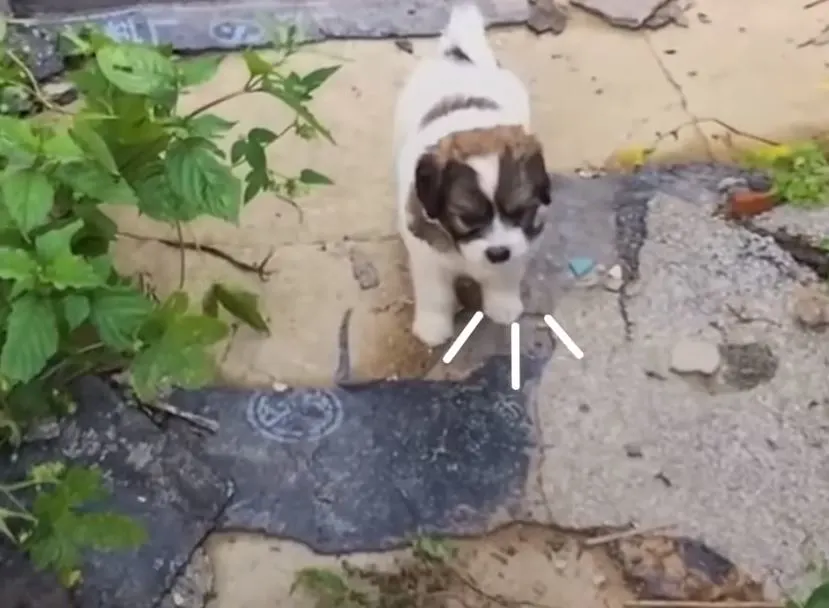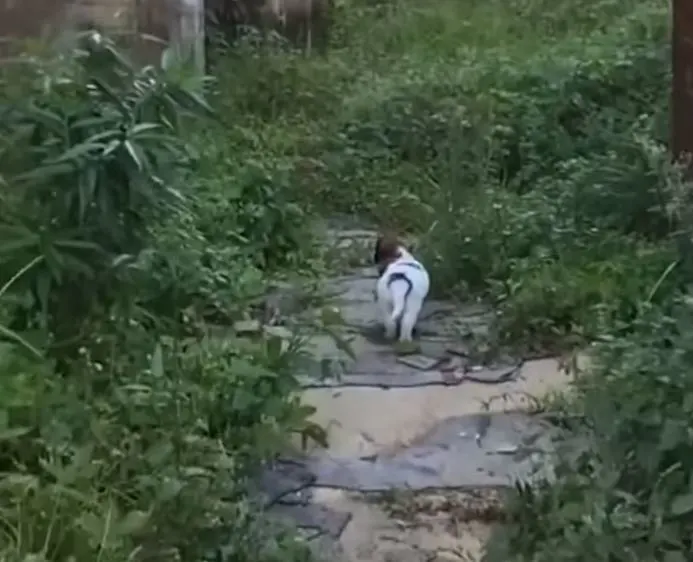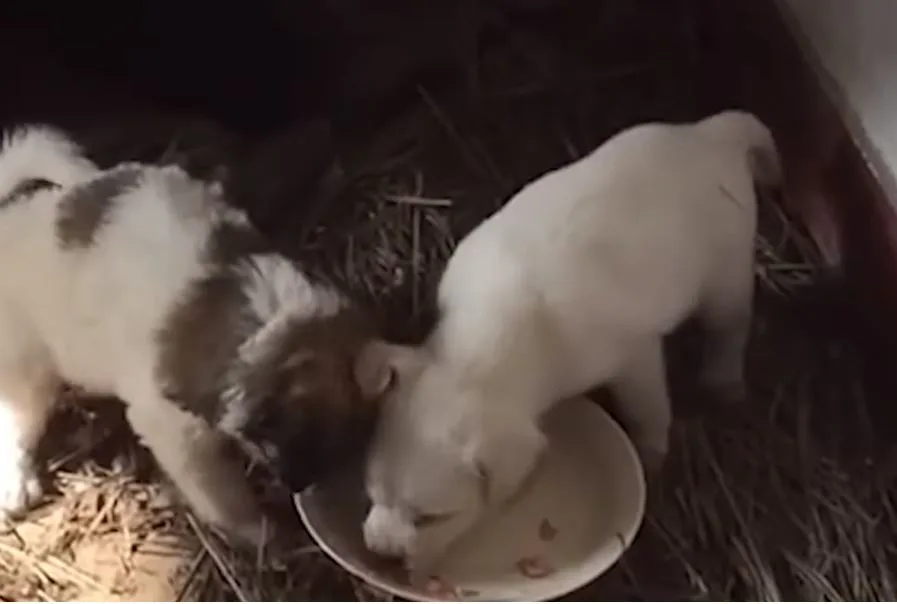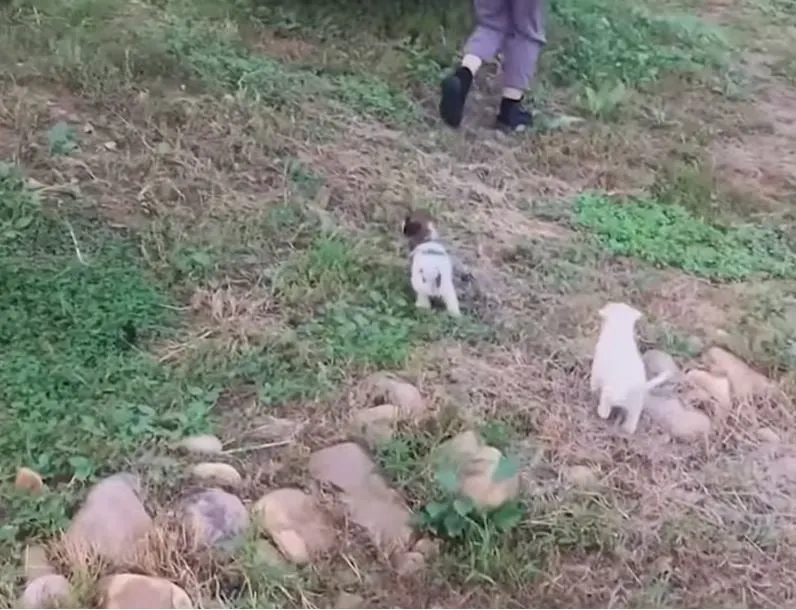A bond between siblings is unbreakable regardless of the species. Dogs are no exception, especially if they are inseparable from birth.
There are plenty of videos of dogs saving their siblings and other animals, but this adorable tiny pup melted our hearts, which is why we had to share this story with you.
His bravery and intelligence just prove once again how amazing doggos are and how big their heart can be.

Cry For Help
A group of volunteers from Northeast Animal Rescue in China came across a beautiful puppy in what seemed to be an abandoned part of a village or a town.
The puppy was crying and looking in all directions as if he was trying to find help. However, when volunteers came near the pup, he turned around and started walking.
The volunteers seemed rather surprised, as it didn’t look like the dog was running away from them. Instead, the pooch looked like he was trying to show them something.

It didn’t take them long to come to an abandoned house, which they entered along with the pup.
Although volunteers knew there was something in the house, what they didn’t expect was another puppy, which was just as cute as the one that brought them there.

Fortunately, rescuers brought some food and water, which the puppies devoured in a couple of minutes.

From Abandoned House To A Home Full Of Love
The rescuers brought both puppies to the shelter where they received a good bath, a vet checkup, and lots of cuddles from the rescue staff.
The puppies seemed to enjoy all of it, but what surprised everyone was the energy they had during play time, although they were starving for days before the rescue.

Unfortunately, there is no available information regarding their adoption, but I am sure such cuties have already found their forever home.
I just hope they were adopted together because of their special bond, which should never be broken.

If you’d like to watch the full video of their rescue, click on the link below:
If you’ve ever been greeted by a slobbery smile from your furry friend, you’re probably familiar with the phenomenon of dog drool. It’s a common sight for dog owners, but have you ever wondered why dogs drool so much? Well, let’s take a closer look at this endearing yet sometimes messy behavior. Dogs have a unique way of communicating with us, and their drooling habits can reveal more than just their love for treats.
Whether your pup is eagerly awaiting mealtime or excited to see you after a long day, their drooling tendencies can vary in different situations. Understanding the reasons behind why dogs drool can provide insight into their overall health and well-being. So, next time you find yourself wiping away drool, remember that it’s all part of the charming package that comes with having a canine companion by your side.
Understanding Dog Drool
The Biology of Dog Saliva
Dog saliva plays a crucial role in the digestive process. It contains enzymes that kick-start the breakdown of food even before it reaches the stomach. This pre-digestion action helps dogs efficiently extract nutrients from their meals. Additionally, dog saliva helps lubricate the mouth, making it easier for dogs to chew and swallow their food.
What Drooling Does for Dogs
Drooling is a natural behavior for dogs and serves various purposes. One common reason for drooling is to cool down. Dogs don’t sweat like humans do, so panting and drooling are mechanisms they use to regulate body temperature. When a dog is overheated, you may notice increased drooling as a way for them to cool off. Another reason for drooling is excitement or anticipation, such as when a dog sees their favorite treat or toy. It’s their way of expressing their emotions in a tangible manner.
Common Reasons Why Dogs Drool
Hunger and Anticipation of Food
When your dog’s food is being prepared, or they see you preparing your meal, they may start drooling excessively. This reaction is a natural response linked to their survival instincts and the expectation of a tasty meal. Dogs relate the sight and smell of food to eating, triggering the drooling response as they get ready to enjoy their meal.
Oral Health Issues
Drooling can also be a sign of oral health problems in dogs. Issues like dental infections, gum disease, or mouth sores can lead to increased saliva production and drooling. If you notice excessive drooling accompanied by other symptoms like bad breath or reluctance to eat, it’s essential to consult your vet for a thorough oral health check-up.
Heat and Exercise
During hot weather or intense physical activity, dogs pant to regulate their body temperature. However, in situations where panting may not be sufficient, they might drool to cool down. Excessive drooling in these conditions is a way for dogs to manage their body heat and prevent overheating, especially in breeds more prone to heat sensitivity.
Breed-Specific Tendencies to Drool
Certain dog breeds have a genetic predisposition to drooling more than others. Breeds like Bulldogs, St. Bernards, and Mastiffs are known for their tendency to drool due to their jaw and mouth structures. This breed-specific trait is a natural occurrence and doesn’t necessarily indicate any health issues. If you have a breed with a predisposition to drooling, regular maintenance of their mouth and facial folds can help manage excessive drool.
When to Worry About Drooling
Normal Vs. Excessive Drooling
When it comes to your furry friend and drooling, it’s essential to understand what’s normal and what’s a cause for concern. A little drool here and there, especially after a yummy meal or exciting playtime, is pretty standard for most dogs. However, excessive drooling that seems out of the ordinary could indicate an underlying issue that needs attention.
Signs of Illness Related to Drool
If you notice a sudden increase in drool or your dog’s drooling habits change significantly, it might be a sign of an underlying health problem. Keep an eye out for other symptoms like bad breath, appetite changes, excessive thirst, vomiting, diarrhea, or lethargy. These signs, coupled with abnormal drooling, could indicate an illness that requires a trip to the vet for a check-up.
Managing Your Dog’s Drool
Regular Veterinary Check-Ups
Make sure your furry companion has regular veterinary check-ups to monitor their overall health, including any issues related to drooling. Your vet can help identify any underlying health problems early on and provide appropriate treatment.
Drool-Proofing Your Home
To keep your living space clean and drool-free, consider using pet-friendly covers and mats in areas where your dog spends time. Keep clean towels handy to wipe away drool, and consider using stainless steel bowls to reduce slobbering.
Training and Conditioning
Train your dog to control their drooling through conditioning techniques. Reward good behavior and discourage excessive drooling. Use positive reinforcement methods to teach your dog when it’s appropriate to drool, such as during mealtime, and when to avoid excessive drooling in other situations.
Conclusion
You’ve learned all about why dogs drool and how it plays a crucial role in their communication and well-being. From digestion to genetic predispositions, various factors contribute to this natural behavior. Understanding the difference between normal and excessive drooling is key to monitoring your furry friend’s health. By staying proactive with regular vet check-ups, creating a drool-friendly environment at home, and using effective training methods, you can manage your dog’s drooling habits. Remember, a little drool is just a part of being a dog, but excessive drooling could signal an underlying issue that needs attention. Keep your pup happy and healthy by staying informed and taking the necessary steps to keep their drooling in check.
Frequently Asked Questions
Why do dogs drool so much?
Dogs drool as a way to communicate, regulate body temperature, and aid in digestion. Hunger, oral health, heat, exercise, and breed tendencies can also contribute to drooling.
Is dog drooling a sign of health issues?
Normal drooling is common, but excessive drooling may indicate underlying health concerns. It’s essential to monitor drooling patterns and seek veterinary advice if there is a sudden change in drooling behavior.
How can I manage my dog’s excessive drooling?
Regular veterinary check-ups help monitor your dog’s health and identify potential issues causing excessive drooling. Drool-proof your home with pet-friendly covers and mats, and use training techniques to control drooling behavior effectively.
[no_toc]

Hey there, I’m Janet Brooks, a dog-loving student from California. I’m all about helping pups in need, especially those without homes. Me and my awesome friends work together to give shelter and love to stray dogs. Oh, and I also write blogs about dogs to share helpful info.